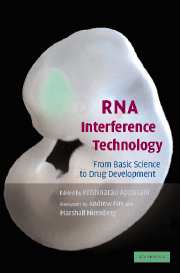Book contents
- Frontmatter
- Contents
- Foreword by Andrew Fire
- Foreword by Marshall Nirenberg
- List of Contributors
- Introduction
- Section one Basic RNAi, siRNA, microRNAs and gene-silencing mechanisms
- 1 RNAi beginnings, Overview of the pathway in C. elegans
- 2 Dicer in RNAi: Its roles in vivo and utility in vitro
- 3 Genes required for RNA interference
- 4 MicroRNAs: A small contribution from worms
- 5 miRNAs in the brain and the application of RNAi to neurons
- Section two Design, synthesis of siRNAs
- Section three Vector development and in vivo, in vitro and in ovo delivery methods
- Section four Gene silencing in model organisms
- Section five Drug target validation
- Section six Therapeutic and drug development
- Section seven High-throughput genome-wide RNAi analysis
- Index
- Plate section
- References
2 - Dicer in RNAi: Its roles in vivo and utility in vitro
Published online by Cambridge University Press: 31 July 2009
- Frontmatter
- Contents
- Foreword by Andrew Fire
- Foreword by Marshall Nirenberg
- List of Contributors
- Introduction
- Section one Basic RNAi, siRNA, microRNAs and gene-silencing mechanisms
- 1 RNAi beginnings, Overview of the pathway in C. elegans
- 2 Dicer in RNAi: Its roles in vivo and utility in vitro
- 3 Genes required for RNA interference
- 4 MicroRNAs: A small contribution from worms
- 5 miRNAs in the brain and the application of RNAi to neurons
- Section two Design, synthesis of siRNAs
- Section three Vector development and in vivo, in vitro and in ovo delivery methods
- Section four Gene silencing in model organisms
- Section five Drug target validation
- Section six Therapeutic and drug development
- Section seven High-throughput genome-wide RNAi analysis
- Index
- Plate section
- References
Summary
Introduction
In its infancy, RNA interference (RNAi) was simply an intriguing curiosity; now it has leapt to the forefront of science (Couzin, 2002). The growth spurt of RNAi-related studies has been partly pragmatic – RNAi clearly had the potential to evolve into an incredibly powerful technology for manipulating gene expression in diverse cell types, and to a great extent this potential has been realized. Moreover, as a physiological phenomenon, RNAi represents a fascinating and previously unrecognized level of cellular regulation. RNAi is essential for silencing of heterochromatin (Reinhart and Bartel, 2002; Volpe et al., 2002; Schramke and Allshire, 2003; Volpe et al., 2003) and gene expression via methylation (Grant, 1999; Jones et al., 1999), for antiviral defense, at least in plants (Baulcombe, 1999; Grant, 1999; Ratcliff et al., 1999), for controlling the expression of transposable elements and repetitive sequences (Ketting et al., 1999; Tabara et al., 1999; Ambros et al., 2003a&b; Sijen and Plasterk, 2003), and for proper embryonic development (Grishok et al., 2001; Hütvagner et al., 2001; Ketting et al., 2001; Knight and Bass, 2001; Bernstein et al., 2003; Houbaviy et al., 2003).
This chapter focuses on Dicer, an RNAse III family enzyme essential for sequence-specific gene suppression. We begin with an overview of the discovery of Dicer and its implication in RNAi, followed by a discussion of its hypothesized roles in vivo.
- Type
- Chapter
- Information
- RNA Interference TechnologyFrom Basic Science to Drug Development, pp. 29 - 54Publisher: Cambridge University PressPrint publication year: 2005



